Introduction
The Czerniachowicz surname is a rare and historically rich name with deep roots in the Polish–Lithuanian Commonwealth. This page explores its origins, linguistic development, geographical distribution, noble heritage, and cultural significance.
For those tracing their ancestry, this page offers valuable insights, historical records, and genealogical resources to uncover the story of the Czerniachowicz family.
Czerniachowicz is pronounced CHER-NY-AHK-OW-ITCH. Here is a more detailed breakdown:
- Czer - pronounced like "CHER"
- -ni - pronounced like "NY"
- -ach - pronounced like "AHK"
- -ow - pronounced like "OW"
- -icz - pronounced like "ITCH"
Table of Contents
- Etymology & Linguistic Origins
- Historical Geographical Distribution
- Nobility and Heraldic Associations
- Notable Historical Figures
- Cultural & Historical Context
- Geographical Distribution and Historical Presence
- Migration & Diaspora
- From Tragedy to Resettlement
- Available Genealogical Resources
- Family Branches and Ongoing Research
- Conclusion
1. Etymology & Linguistic Origins
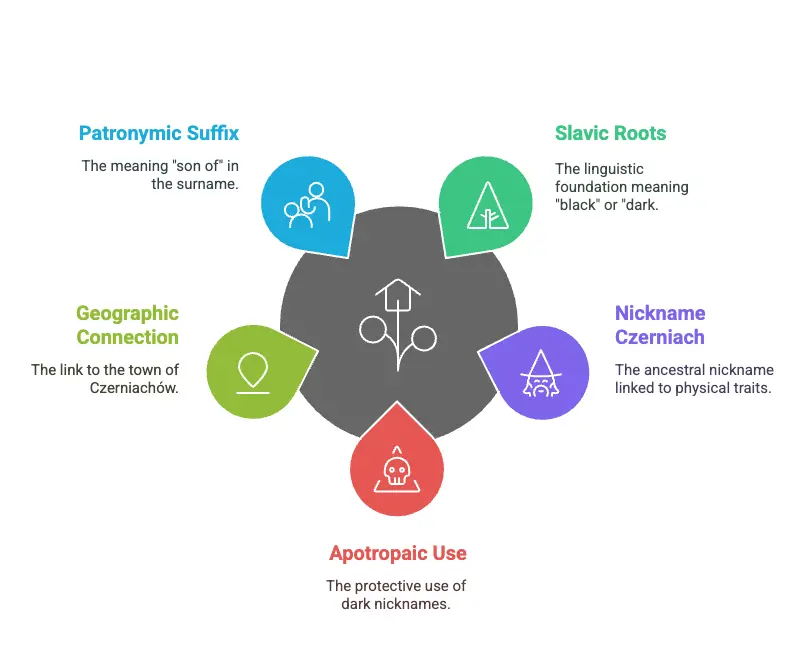
The surname Czerniachowicz has clear Slavic roots, likely combining a descriptive nickname with a patronymic suffix.
Root Meaning - "Black/Dark"
The core element czern- derives from the Proto-Slavic čьrnъ, meaning "black" or "dark", which survives in modern Polish as czarny. It likely described a physical trait (dark hair, complexion) or a habitual feature (for example dark clothing).
Personal or Place-based Origin?
Two overlapping possibilities exist:
- A nickname origin: Czerniach may have been an ancestor's given name or byname.
- A habitational origin: The town of Czerniachów (modern-day Cherniakhiv, Zhytomyr Oblast, Ukraine) provides a plausible geographical root. It was common for szlachta to take surnames from estates or regions.
Given the strong Slavic linguistic structure and known historical presence in the area, both origins may be valid. In practice the name likely reflects a family originally from Czerniachów, descending from an ancestor known as "the dark one". The place name itself probably shares the same "czern-" root, possibly referencing dark soil, dense forests, or a founder named Czerniach. This kind of overlap between personal epithet and place identity is typical for the region.
In some cases such nicknames were used in an apotropaic (protective) sense. For example, calling a child "dark" or "bad" to ward off evil spirits, even though the parents hoped for a healthy and fortunate child.
Suffix -owicz
The -owicz suffix is a traditional patronymic ending in Polish, Belarusian, and Ukrainian, meaning "son of". In this case, Czerniachowicz translates most directly as "son of Czerniach".
Spelling Variants
- Polish: Czerniachowicz (IPA: /ˈt͡ʂɛr.ɲaˌxɔ.vit͡ʂ/)
- Ukrainian/Belarusian: Черняхович (transliterated Cherniakhovych or Chernyakhovich)
- Lithuanian: Rare, likely recorded as Černiachovič in Polonised form if it appears at all
2. Historical Geographical Distribution
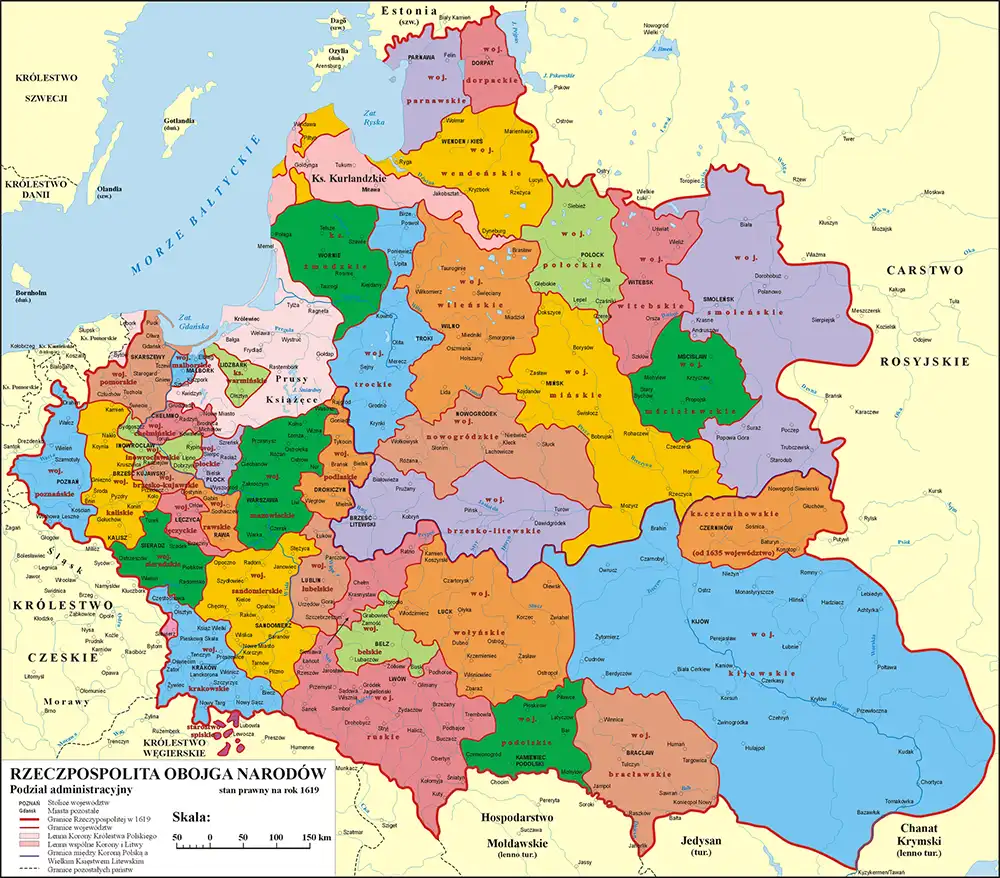
Map of the Polish-Lithuanian Commonwealth (Rzeczpospolita Obojga Narodów) in 1619, showing its administrative divisions and territorial extent at the time. The Commonwealth was a dual monarchy composed of the Kingdom of Poland and the Grand Duchy of Lithuania, including modern-day Poland, Lithuania, Latvia, Belarus, Ukraine, and parts of Russia.
Poland & Lithuania (Historical Commonwealth)
Historically, Czerniachowicz was most prevalent in the eastern regions of the old Polish–Lithuanian Commonwealth, especially in present-day Belarus and Ukraine (former eastern Poland). Archival and census evidence shows the surname in Wołyń (Volhynia) and neighbouring areas over the 18th to 20th centuries. For example, in the Volhynia guberniya nobility registers under Russian rule, the Czerniachowicz family is recorded from 1832 through 1918, indicating a continuous presence and recognition of nobility in that region.
Ukraine (Volhynia, Podolia, Kiev region)
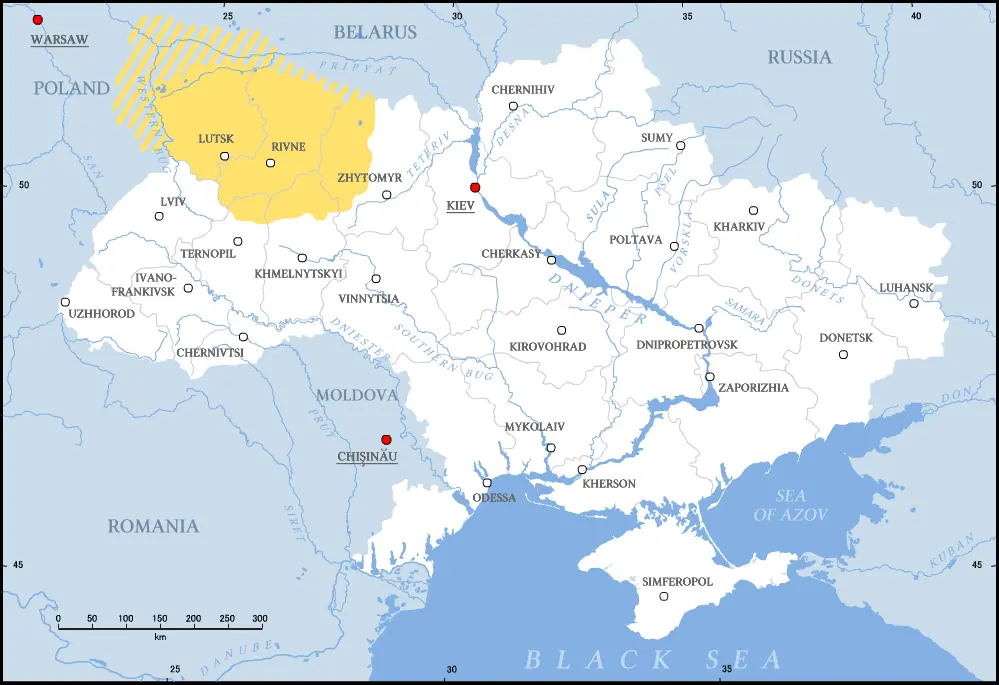
The surname Czerniachowicz has historical ties to Volhynia and Podolia, regions that correspond to northwestern and southwestern Ukraine today. Records spanning the 18th and 19th centuries confirm the surname's presence in multiple locations. In Volhynia, the town of Ostróg (now Ostroh, Ukraine) and its surrounding villages, such as Czerniachów, had individuals with the surname, as evidenced by 19th century church parish records, suggesting deep local roots.
The surname is further documented in noble registries and records, appearing in parish registers of towns like Nowogród Wołyński (Novograd-Volynsky) and Korzec (Korets) around 1900. Additionally, Volhynian documents from 1832 through 1918 consistently list the surname, reinforcing its long-standing presence in the region. A 1938 Polish voter register from Kowel (Kovel) county also includes the name, confirming its existence in northwest Volhynia on the eve of World War II.
Within Ukraine, the surname also persisted in the Kiev area. After the partitions of Poland, Kiev and Volhynia were under Russian rule, and documents in the 19th century (such as the 1897 Imperial census or local tax lists) would list the name in its Cyrillic form. Modern Ukrainian databases confirm the surname still exists in those regions and one search found a significant number of records of Черняхович across many regions of Ukraine, with particular concentration likely in the central and western parts (for example Zhytomyr, Vinnytsia, Kiev oblasts).
Belarus
The surname is also found in areas of today's Belarus, especially the southern and eastern parts that bordered the Volhynia and Kiev lands. It is a typical Ukraino-Belarusian type surname. In regions such as Polesie (Pińsk, Brześć) or the Minsk governorate, the name was borne by members of the gentry or peasantry.
Grand Duchy of Lithuania
Going further back, there are hints the surname may have existed in the Grand Duchy of Lithuania's nobility in earlier centuries. One index of early noble families lists "Czerniachowicz" among names in Mazovia or Dobrzyń land, though details are sparse. That branch may have been small or later moved eastward.
Modern Poland
Within Poland's current borders, Czerniachowicz is quite rare. This is because prior to WWII, the name's bearers mostly lived in the eastern borderlands (Kresy) which were not within post 1945 Poland. After WWII many Polish inhabitants of Volhynia, Podolia, and eastern Galicia were resettled into the new borders of Poland. Today the surname appears sporadically in Poland with only a handful of bearers. For example, individuals or families in Szczecin (north west Poland) or Lower Silesia, likely descendants of those post war repatriates.
3. Nobility and Heraldic Associations
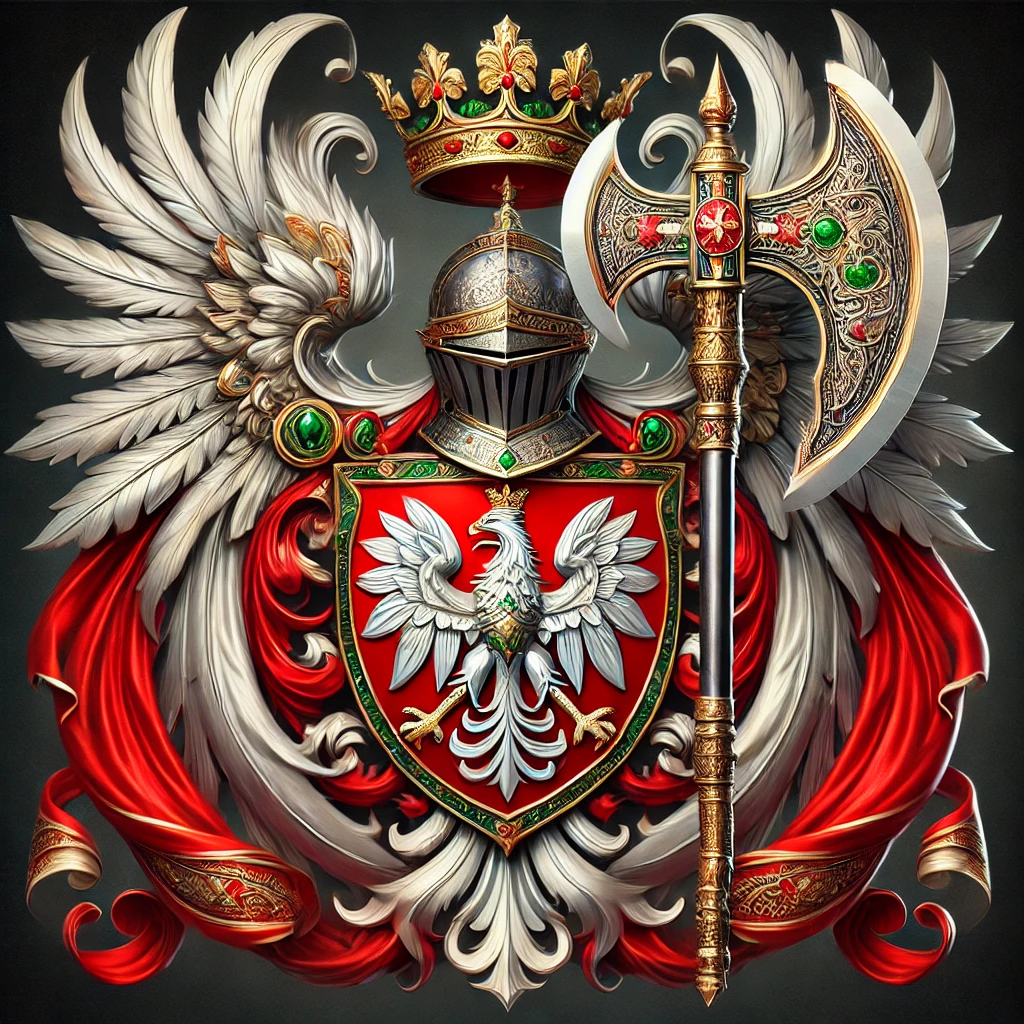
A modern rendition of the "Oksza" coat of arms, which was used by noble families in the Polish–Lithuanian Commonwealth
The Czerniachowicz family belonged to the szlachta, the noble class of the Polish–Lithuanian Commonwealth. Available records suggest they were part of the drobna szlachta, or minor nobility, often landowning but not wealthy. This class played an active role in local governance, military service, and estate management.
A key document confirming noble lineage comes from the Volhynian Nobles' Deputation in the Russian Empire, dated 29 December 1802 (Record No. 2925). This post partition record formally recognised the noble status of a Czerniachowicz family line in Volhynia and explicitly associated them with the Oksza coat of arms.
However, there is some heraldic ambiguity. While primary evidence for the Volhynian branch supports the Oksza arms, the modern armorial by Tadeusz Gajl lists Czerniachowicz as bearing the Śreniawa (Szreniawa) coat of arms.
There are a few plausible explanations:
- Multiple branches of the family may have existed, each affiliated with a different heraldic clan.
- Heraldic confusion could have occurred during documentation, especially among lesser nobility.
- Some attributions may stem from secondary compilations or transcription errors involving similar surnames.
At present, the most concrete evidence supports the Oksza arms for the Volhynian branch. Śreniawa may relate to a different line or to later confusion in armorials.
| Coat of Arms | Description | Source Evidence |
|---|---|---|
| Oksza | A silver battle axe on a red shield, with a golden haft, and the same axe in the crest. | 1802 Volhynian confirmation, nobility registers, and secondary heraldic summaries |
| Śreniawa | A silver charge resembling a bend with a cross pattée on a red shield, with a lion in the crest. | Tadeusz Gajl's Herbarz Polski and other secondary sources |
4. Notable Historical Figures
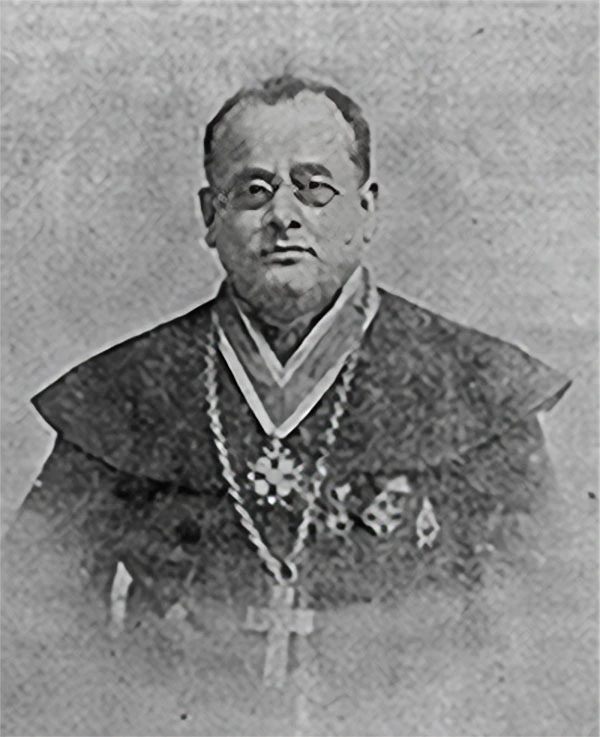
While no individuals bearing the Czerniachowicz surname are known to have held major state offices, several figures do appear in local records, ecclesiastical archives, and administrative documents. They offer insight into the lives and status of various family members.
Rev. Nikodem Czerniachowicz (Nikodim Chernyakhovich)
A Roman Catholic priest active in the late 19th and early 20th centuries within the Russian Empire. He served in the Diocese of Kherson and Tiraspol (modern-day southern Ukraine and Moldova) and was elevated to honorary canon and papal prelate. During World War I he is noted as heading a hospital section for the Polish community under the Mykolaiv Philanthropic Society. His career reflects continued education, clerical engagement, and cultural identity in the family under imperial Russian rule.
Józef Czerniachowicz
Born in 1918 in Bronica, in the Wołyń Voivodeship of the Second Polish Republic (now Ukraine). His inclusion in interwar Polish military records highlights the family's enduring identification with Polish national structures, even in regions that later fell under Soviet control.
Antonina Czerniachowicz
Appears in an 1883 marriage record from the parish of Tarczyn in the Masovian Voivodeship of central Poland, listed as the mother of the groom, Władysław Zalewski. This may indicate internal migration within Poland or marital ties to more central regions.
C. Czerniachowicz
Referenced in a 1939 Ukrainian regional newspaper, where they authored an article on collective farm work. This mention, though fragmentary, suggests that members of the family continued to live and work under the Soviet system, including in local press and propaganda.
Valentina Vasilyevna Chernyakhovich
The Book of Memory of the Autonomous Republic of Crimea lists Valentina Vasilyevna Chernyakhovich (b. 1908) as one of the individuals who suffered political repression in Crimea under the Soviet regime. The "Rehabilitated by History" series is based on extensive archival research, primarily using investigation files held by security services and state archives. Valentina is likely a distant relative who remained in Soviet territory.
Judge I. Chernyakhovich
A modern judicial figure in Zhytomyr, Ukraine, referenced in a decision by the Zhytomyr District Administrative Court. Though contemporary, this illustrates the persistence of the surname in a region historically linked to the family.
Jan, Józef and Stanisław Czerniachowicz (Krasna Słoboda branch)
Family research, particularly by Olya Chernyhovych, has brought together parish records and family memory for a household in the village of Krasna Słoboda (later associated with Katiukha) headed by Jan Czerniachowicz and his wife Teofila, born Zagórska. Copies of a 1907 baptismal entry from the Novograd-Volynsk Roman Catholic parish and a 1914 confessional list show Teofila with her children Antoni, Józef, Stanisław, Jan, Jadwiga, Anna, and Helena, and indicate that she was already widowed by 1914. Family accounts, set against the wider historical context of the NKVD Polish Operation, hold that two of the brothers, Józef and the younger Jan, were arrested and executed in 1937, while Stanisław died during the Second World War. These details match known patterns of repression in the region but have not yet been confirmed in individual execution files, so they should be read as informed family memory rather than final proof.
Yakiv Karlovych Chernyakhovich
A record in a Ukrainian database of repression victims lists Yakiv Karlovych Chernyakhovich, born 1890, from the wider region that borders Volhynia. The patronymic "Karlovych" suggests a father named Karol, which is consistent with typical Polish naming patterns. Although the exact relationship to Antoni's line is not yet proven, Yakiv's age, geography, and surname make him a strong candidate for a close relative, possibly a cousin from another branch that remained in Soviet territory and faced repression.
5. Cultural & Historical Context
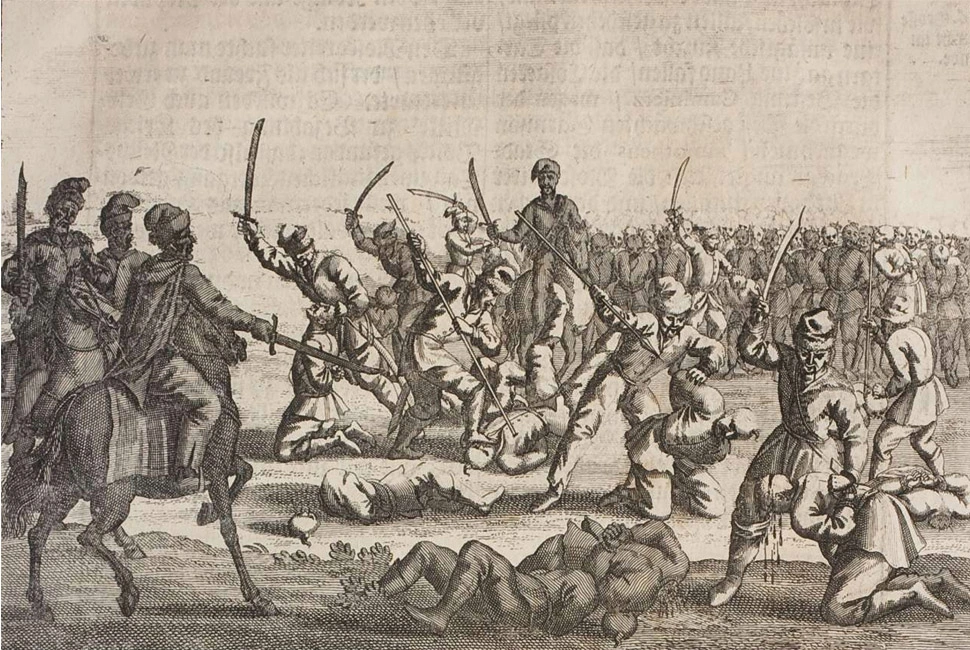
The trajectory of the Czerniachowicz surname offers a lens into the major historical events of Eastern Europe. The family's early presence in Volhynia means they would have lived through the tumult of the Khmelnytsky Cossack Uprising (1648) and the subsequent wars that ravaged that region. Many Polish nobles in Volhynia were killed or fled during the uprising. Those who survived or returned when the Commonwealth reasserted control often had to rebuild from ruin. It is very likely that the Czerniachowicz family's status by the eighteenth century was shaped by these events. They may have been among the lesser nobility who lost estates in the mid 1600s and later obtained new land grants or served under more powerful magnates to maintain their status.
During the Partitions of Poland (1772 to 1795), Volhynia and Podolia fell to the Russian Empire. Polish nobles there had to swear loyalty to the tsar and prove their noble lineage to be officially recognised, or face loss of privileges. The Czerniachowiczes, as evidenced by the 1802 and later documents, successfully legitimised their nobility. This allowed them to retain certain property rights and social standing under Russian rule.
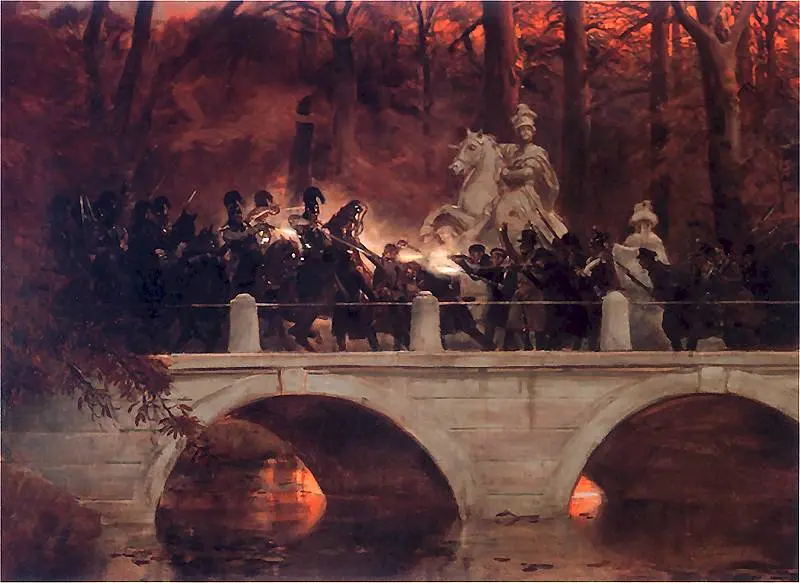
The nineteenth century brought Poles in the empire repeated upheavals. The November Uprising of 1830 to 31 and January Uprising of 1863 saw many szlachta in the Kresy participate or support rebels. We do not yet have specific records of a Czerniachowicz in these insurrections, but it is plausible that some sympathised. After 1863, the Russian regime intensified Russification. Polish nobles in the northwest provinces often had their estates confiscated or were exiled to Siberia. Any Czerniachowicz who was involved in patriotic activities could have suffered such a fate, which might partly explain why by the early 1900s some family members were impoverished or working as clerks rather than as landed gentry.
The world wars sealed the family's dispersal. World War I and the Russian Revolution turned Volhynia into a warzone, with shifting fronts and refugee crises, possibly pushing some Czerniachowiczes west into ethnographic Poland. In 1921, Volhynia became part of the Second Polish Republic, giving roughly two decades where the family was once again under a Polish state. They would have been a small minority in a province with a very mixed population of Poles, Ukrainians, and Jews. By World War II, with Soviet invasion in 1939, any remaining Polish nobles like the Czerniachowicz family were targeted for deportation as "class enemies". The story of Antoni in Siberia and Uganda is emblematic of thousands of Polish families from the Eastern Borderlands. After the war, with Volhynia ceded to the USSR, the cultural landscape changed. The surname almost vanished locally as Poles left, were killed, or assimilated.
The NKVD Polish Operation and targeted repression
Between 1937 and 1938, the NKVD carried out a so called "Polish Operation" under Order 00485. At least tens of thousands of ethnic Poles across the Soviet Union were arrested, and the majority of those convicted were executed. Zhytomyr oblast, which includes the wider area around Krasna Słoboda and Katiukha, suffered one of the highest execution rates in Ukraine. Polish sounding surnames ending in "-ski" or "-wicz" were deliberately targeted. Families with any contact with foreign countries, for example receiving a parcel or scarf from relatives in England, fell under particular suspicion and could be accused of espionage on that basis alone.
Research into Katiukha shows that in the 1930s at least 15 residents of the tiny village were arrested and 6 were shot. In a community that had only 18 households in 1906 this would have been a devastating blow. It helps explain why the Krasna Słoboda or Katiukha branch of the family disappears from open records and why later generations adopted more neutral, Russified forms of the name such as Chernyhovych or Chernyakhovich and avoided speaking about family links to Poland.
Nationality and spelling have shifted with these events. What was once a clearly Polish noble surname in the eighteenth century might appear in Soviet records as a Ukrainian or Belarusian name, simply because of place of residence or administrative category.
Some branches have remained in Belarus or Ukraine, adapting the spelling to Cherniakhovich or Chernyakhovych. For example, people named Черняхович in Belarusian and Ukrainian local records today are very likely distant relatives from the same old noble stock, now fully Belarusian or Ukrainian in identity. Border changes, repression, and assimilation all make the family harder to trace, but they do not break the underlying continuity.
6. Geographical Distribution and Historical Presence

The surname Czerniachowicz has historically been concentrated in the eastern territories of the Polish–Lithuanian Commonwealth, particularly in regions now within Ukraine and Belarus. While rare today, the name can be followed through scattered mentions in civil, ecclesiastical, and nobility-related documents.
Historical Origins and Movement
- Seventeenth century: a branch of the family is recorded in the Kiev Voivodeship around 1630, suggesting noble status and landholding in this frontier region of the Commonwealth.
- Nineteenth century: by the early 1800s, family members were living in Volhynia, a culturally Polish but politically contested area that later came under Russian rule.
- These territories formed part of the Kresy Wschodnie (Eastern Borderlands), a volatile zone shaped by frequent wars, border shifts, and multi-ethnic populations.
Krasna Słoboda and Katiukha
Family research, especially by Olya Chernyhovych, points to the village of Krasna Słoboda in the Nowogród Wołyński area (today in Zhytomyr oblast) as an important ancestral home. A 1900 parish baptism entry and a 1907 record from the Novograd-Volynsk Roman Catholic parish show the village under the name Krasna Słoboda, with Jan and Teofila (born Zagórska) Czerniachowicz baptising their children there. The 1914 confessional list for the same parish lists Teofila and her children, which suggests that Jan had died by that time and that she was recorded as head of household.
The modern village of Katiukha, in Zviahel district, occupies the same general area. Evidence from parish registers and local gazetteers strongly suggests that the pre-Soviet settlement of Krasna Słoboda corresponds to the modern Katiukha, with the name change occurring under Soviet administration. Formal archival confirmation of the renaming would still be ideal, so this should be treated as a well supported identification rather than an official ruling. In any case, Krasna Słoboda and Katiukha clearly form a tightly linked micro-region in which the family were long term residents.
Present day Katiukha covers only a tiny area and is largely overgrown by forest, which matches family descriptions of a once prosperous Polish village that has almost vanished from the landscape.
Modern Distribution (as of 2023)
Despite this deep rooted history, the surname remains extremely rare in contemporary populations.
| Country | Surname Form | Estimated Frequency | Key Locations & Notes |
|---|---|---|---|
| Poland | Czerniachowicz | 72 individuals | PESEL registry data |
| Ukraine | Черняхович | Very rare | Historically present in Zhytomyr Oblast, Volhynia, and in the Kherson or Tiraspol dioceses. Likely only a few families. |
| Belarus | Черняхович | Very rare | Eastern borderlands, the name appears infrequently in Belarusian public databases and in social networks. |
| Russia | Черняхович / Chernyakhovich | Exceptionally rare | Likely via migration from Belarus or Ukraine. Available public records return only a very small number of entries. |
| Lithuania | Czerniachowicz, Polonised | No firm modern records | Possible historical presence, but no clear archival evidence yet found. |
Anglosphere: Czerniachowicz is almost absent in English speaking countries. A few cases exist due to post war migration. For example, at least one family by this name resides in the United Kingdom, and there are isolated cases in North America and Australia, typically traceable to a single immigrant family in each country.
The surname's scarcity today suggests it may have:
- Originated from a single noble family line, rather than many unrelated branches.
- Been heavily reduced by wars, deportations, and assimilation, especially in the 20th century.
- Never spread widely outside its original region, in contrast with more common surnames.
Notable Trends
Outside Poland, estimates depend on indirect data because Belarus and Ukraine do not publish detailed surname frequency tables for the general public. Global totals are pieced together from local references, online indexes, and national data where available.
The consistent picture is that Czerniachowicz or Черняхович is a very low incidence surname everywhere.
One striking fact about Czerniachowicz or Черняхович is just how rare it is. Even in its strongest territory, Poland, 72 bearers is very low. Globally the total is probably only in the low hundreds. This rarity suggests a single or very small group of founding families, combined with the severe demographic losses of the 20th century. It also means that each new record is genealogically significant, because the chances of coincidence are small.
7. Migration & Diaspora
The turbulent history of Eastern Europe across the 19th and 20th centuries drove significant migration, and the Czerniachowicz family was not immune to these broader forces. Although direct records are limited due to the surname's rarity, several key emigration patterns and historical pressures suggest how and why the family spread beyond its ancestral homeland.
Initial emigration from Volhynia and Podolia (under Russian Imperial rule) due to economic hardship and repression, particularly following failed Polish uprisings.
Individuals with the surname appear in North American immigration records, reflecting the wider flow of migrants fleeing instability, poverty, and political tension.
Further migration from Volhynia and eastern Poland toward North and South America, often driven by land shortages and ethnic tensions.
Soviet deportations to Siberia and Central Asia, forced labour under Nazi Germany, and post war border changes led to major population upheaval. Some displaced individuals later resettled in Western Europe or the Americas.
Resettlement of Polish families from former eastern territories to western Poland, and permanent emigration of some refugees to the United Kingdom and other countries.
North America was a common destination. While the surname is rare, it appears in United States immigration and naturalisation databases. On passenger manifests from the early 1900s, Polish or Russian nationals with similar surnames arrive at ports such as Ellis Island. Spellings are often phonetic and distorted, so matching requires some care.
Canada also received immigrants from Eastern Europe, including from Poland's Kresy, during the early 1900s and again in the post war period. There was also significant Polish emigration to South America in the interwar period, particularly to Argentina and Brazil, and it is possible that lesser known branches of the family took this route.
The largest 20th century diaspora of this family resulted from World War II and its aftermath. Eastern Poland, including Volhynia, was devastated by Soviet and Nazi occupations. Polish families with this surname were caught in mass deportations. Notably, my grandfather Antoni Czerniachowicz (born 1898) was among the Poles deported to Soviet forced labour. An archival card records him as a Polish, Roman Catholic inhabitant of Volhynia who was brought to a special settlement in Arkhangelsk Oblast, Kotlassky district, on 29 February 1940 and released from that special settlement on 4 September 1941 under the general amnesty for Polish citizens. Family tradition places him in extremely harsh conditions in the far north before he joined the evacuation route associated with General Anders' Polish forces, which led south through Persia to British controlled territories.
Archival records also confirm that by 1950 Antoni was head of a Polish refugee household in the Koja resettlement camp in Uganda. A nominal roll from April 1950 lists him as about 51 years old, with his wife Helena (also recorded as Waleria), about 37, and two children, Maria and Józef, both aged 2. These children were almost certainly born in Africa, probably in Koja. The same lists name his mother in law, Anna Tchurzewska, aged about 69, as part of the household, which strongly suggests that Helena's maiden name was Tchurzewska or Tchórzewska. After several years in Africa, Antoni and his immediate family were among those offered permanent resettlement in the United Kingdom, where they began a new life.
Within Poland, after WWII, the borders shifted west, and the remaining Polish population of Volhynia and Podolia was expelled or fled. Any Czerniachowicz families who survived likely resettled in Poland's new western territories such as Silesia or Pomerania. Present day Polish data and phonebooks show a small number of families in those regions.
At the same time, other branches remained in Belarus or Ukraine and adapted the spelling to Cherniakhovich or Chernyakhovych. These lines experienced Soviet rule directly and often paid a high price through repression, execution, or forced silence about their identity.
8. From Tragedy to Resettlement
The history of the Czerniachowicz name is more than a chronicle of noble heritage and migration. It is a story of resilience, survival, and renewal. It is part of a larger narrative shared by many Poles who were uprooted, displaced, and forced to forge new lives far from their homeland. During and after the war, over a million Polish citizens were deported to forced labour camps in the Soviet Union, while others, like my grandfather, found themselves scattered across the world, seeking refuge in places as far flung as India, Africa, and the Americas.

For the branch that passed through Koja in Uganda, exile brought both loss and beginnings. Cemetery and memorial records from East Africa record the deaths of two of Antoni and Helena's daughters, Jadwiga and Bogumiła Apolonia, who died in childhood during the years in Africa, one from malaria and one from pneumonia. Their graves, far from Volhynia, are a tangible reminder of how far the family had been driven. At the same time, Koja and other Polish settlements in Africa became "little Polands", with schools, chapels, and community life rebuilt in difficult conditions.
After the war ended, returning home was often not an option. With Poland under Soviet control, many Poles who had fought for the Allies or escaped Soviet captivity found themselves stranded, unable to return to a country that no longer welcomed them. For those who resettled in the UK, towns with Polish communities became their new homes, where they continued to preserve their traditions while contributing to the societies that had given them refuge.
By retracing these steps, we honour the shared experience of the Polish diaspora, of those who lost their homeland yet carried its memory with them. Memorials and cemetery records, such as those found on the Polskie Cmentarze website, serve as reminders of both the lives lost and the extraordinary resilience of those who survived.
9. Available Genealogical Resources
For anyone exploring the Czerniachowicz family line, the surname's rarity is both a challenge and an opportunity. With few branches and limited dispersion, even a single record can offer significant insight.
Here is how to start:
Use spelling variations
When searching, try spelling variants such as: Cherniakhovich, Chernyakhovich, Czerniachovicz, Czernichowicz, and Черняхович (Cyrillic).
Focus geographically
Start in historically connected regions:
- Poland: Masovian Voivodeship, Volhynia, Lublin, and post war western territories.
- Ukraine: Zhytomyr Oblast, Volyn, Kyiv region.
- Belarus: Brest and Minsk archives may contain relevant entries.
Target specific archives
These are the most likely to yield results:
| Archive/Database | Focus Area | Notes |
|---|---|---|
| Geneteka | Poland | Indexed parish records (geneteka.genealodzy.pl) |
| Szukaj w Archiwach | Poland | Polish State Archives search portal |
| AGAD | Central Poland | Holds older Commonwealth era nobility files and some Volhynian material |
| Zhytomyr State Archives | Ukraine | Vital records, parish registers, and nobility files for the region that includes Krasna Słoboda and Katiukha |
| NIAB (Belarus) | Belarus | Nobility and vital records |
| FamilySearch | Global | Free digitised immigration, parish, and civil records |
| CEMLA | Argentina | Immigration records (cemla.com) |
Victims of repression databases
For branches that remained in Soviet territory, specialist databases are crucial:
- Memorial database (base.memo.ru) for victims of Soviet political terror across the USSR.
- Ofiaryterroru.pl for victims of the NKVD Polish Operation, searchable by Polish and Cyrillic forms of the surname.
- Ukrainian martyrology projects that list rehabilitated victims in regions such as Zhytomyr, including execution and rehabilitation data.
British and diaspora sources
To trace the British and wider diaspora:
- The National Archives in Kew (naturalisation papers and alien registration cards).
- The Polish Institute and Sikorski Museum in London (testimonies and records of exiles and soldiers).
- Polish Catholic Mission parish records for marriages and baptisms in the UK.
- Archives relating to Polish resettlement camps and cemeteries, including Koja in Uganda and post war camps in England.
Consider DNA testing
Because of the surname's rarity, Y-DNA testing among living male descendants may help determine whether geographically separate branches (for example Poland and Belarus) descend from a common ancestor.
Engage with genealogy communities
Polish and Eastern European genealogy forums, Facebook groups, and societies (for example the Polish Genealogical Society of America) often provide assistance with translation, search techniques, and document interpretation.
Other sources
Researching the Czerniachowicz surname requires delving into Polish, Lithuanian, Ukrainian, and Belarusian records. A variety of online databases, archives, and genealogical resources can help piece together the family history:
- Nobility and heraldry sources: Classic heraldic compilations like Boniecki's "Herbarz Polski" and Niesiecki's "Herbarz" may contain mentions of the surname. Modern works such as Tadeusz Gajl's "Herby Szlachty Rzeczypospolitej" list the surname with a coat of arms.
- Church records: Parish registers of births, marriages, and deaths from Volhynia and Podolia many of which have been microfilmed or digitised are essential. These records can often be found in the archives of AGAD or on platforms such as FamilySearch.
- Census and residency records: The 1897 Russian Imperial Census and interwar Polish voter lists (for example from Kowel in 1938) provide valuable demographic details.
- Military records: Polish Armed Forces archives offer information on individuals such as Józef Czerniachowicz born 1918, and on other conscripts from Volhynia.
- Immigration and passenger lists: Databases from Ellis Island, Castle Garden, and Canadian immigration records can help trace the diaspora.
- Online genealogical databases: Websites like FamilySearch, Ancestry, MyHeritage, and Forebears provide searchable indexes and family trees that may include the surname or its variants.
- Genealogical societies and forums: Engaging with communities such as Polish genealogical societies and dedicated Volhynia forums can offer additional leads and local expertise.
- Digital libraries and archives: Resources such as Polona (the Polish National Digital Library) host a variety of publications relevant to the family history.
By combining these sources from heraldic directories and church registers to military records and immigration manifests, it is possible to construct a detailed picture of the Czerniachowicz family's history across borders and centuries.
10. Family Branches and Ongoing Research
As more records surface, it has become clear that the family story is best understood in terms of related branches shaped by geography and politics.
The Volhynian or Ukrainian branch
This branch is centred on Krasna Słoboda and Katiukha in the Nowogród Wołyński or Zviahel area of present day Zhytomyr oblast. Parish baptismal and confessional records from 1900 to 1914 show Teofila (born Zagórska) Czerniachowicz living in Krasna Słoboda with her children Antoni, Józef, Stanisław, Jan, Jadwiga, Anna, and Helena, and by 1914 she appears as a widow heading the household. Combined with local memory, these records point to a household earlier headed by Jan and Teofila Czerniachowicz. Family testimony gathered by Olya Chernyhovych suggests that under Soviet rule this branch suffered heavily during the NKVD Polish Operation and later repression, with at least two sons probably executed. Until individual case files are located, these details remain carefully framed family recollections rather than fully documented facts.
The British branch
The British branch descends from Antoni (born 1898), who was deported east by the Soviets, passed through forced labour and evacuation with Polish forces, and then spent several years in the Koja refugee settlement in Uganda. Confirmed records from 1950 list him there with his wife Helena or Waleria, their young twins Maria and Józef, and Helena's mother Anna Tchurzewska. After 1950 the family resettled in England, where the surname continues in a small number of lines.
Other lines
Additional related lines appear in Belarus and Russia under the spelling Черняхович or Chernyakhovich, and in post war Poland, particularly in western regions where families from Volhynia were resettled. These branches may descend from cousins of the Volhynian or Ukrainian line who moved or were displaced in the 19th or 20th century.
Collaboration with Olya Chernyhovych
A significant part of the recent progress in reconstructing the Volhynian branch comes from the independent research of Olya Chernyhovych in Ukraine. Through her work with local archives and family documents, it has been possible to match names, places, and dates between the Soviet side and the diaspora side of the family. Where this page refers to Teofila's full list of children, to the Krasna Słoboda household, or to village level detail about Katiukha, it builds directly on this collaboration. Some points are now supported by documents, others remain well grounded working hypotheses awaiting formal archival copies.
This site is therefore a living project. New records from Ukrainian archives, British files, and family collections may still refine dates, confirm suspected executions, or uncover branches that are currently only names in passing references.
11. Conclusion
The Czerniachowicz surname is more than just a linguistic or historical curiosity. It is my name, and part of my family's lived story.
Though rare today, the Czerniachowicz surname carries a deep and traceable legacy rooted in the eastern frontier of the Polish–Lithuanian Commonwealth. From its Slavic linguistic origins to confirmed noble status and scattered archival mentions, the name reflects the story of a regional gentry family navigating centuries of conflict, shifting borders, and cultural change.
Whether linked to a small estate in Volhynia or a priest in Tsarist Russia, the threads of this family's history mirror the broader fate of the Polish szlachta in Eastern Europe: resilient, adaptive, and profoundly shaped by the continent's most dramatic upheavals.
Researching the Czerniachowicz name has been a personal project, a way of reclaiming part of a story that was nearly lost to history, silence, and distance. What began as a surname on old records has become a thread linking people, places, and generations. Recent collaboration with relatives such as Olya Chernyhovych has joined the British and Ukrainian sides of the story in a way that previous generations could not have imagined.
It is my hope that this site helps others, whether they share the name or not, to better understand the historical landscape that shaped families like mine. Every new document or contact fills another gap in the picture.
If you are a fellow Czerniachowicz, or connected to one, I would be glad to hear from you. Click the button on the bottom right.